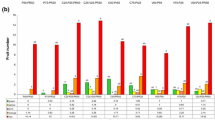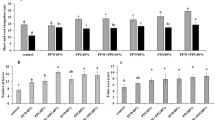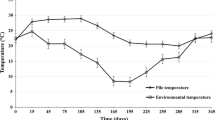Summary
The effect of compaction of the substrate on the growth of tomato varied with both the substrate and the degree of compaction. With most substrates, and in particular the fine-sand series which had a poor structure, any degree of compaction gave adverse effects, whilst with the brickearth series, which had a good structure, a moderate amount of compaction gave a significant increase in growth when peat was included in the substrate.
Peat was a more effective physical conditioner than grit in reducing the adverse effects of compression.
Compaction decreased the fresh weight and internode length of tomatoes and increased the period from pricking out to anthesis. The lower rate of nitrification found in compacted substrates was not responsible for the lower growth rate. Supplementary oxygen applied either as calcium peroxide or hydrogen peroxide had no effect at high substrate densities. It is tentatively suggested that the higher water tensions and mechanical impedance of the high density substrate were the cause of the slower growth.
Similar content being viewed by others
References
Bunt, A. C., Some physical properties of pot-plant composts and their effect on plant growth. I. Bulky physical conditioners. Plant and Soil13, 322–332 (1961).
Cavell, A. J., A rapid method for the determination of nitrogen, phosphorus, and potassium in plant materials. J. Sci Food Agr.5, 195–200 (1954).
Gill, W. R. and Miller, R. D., A method for study of the influence of mechanical impedance and aeration on the growth of seedling roots. Soil Sci. Soc. Am. Proc.20, 154–157 (1956).
Melsted, S. W., Kurtz, T., and Bray, R., Hydrogen peroxide as an oxygen fertiliser. Agron. J.41, 97 (1949).
Peech, M. and English, L., Rapid microchemical soil test. Soil Sci.57, 167–195 (1944).
Smith, F. W. and Cook, R. L., Effect of soil aeration, moisture and compaction on nitrification and oxidation and the growth of sugar beets following corn and legumes in pot cultures. Soil Sci. Soc. Am. Proc.11, 402–406 (1946).
Taylor, S. A., Oxygen diffusion in porous media as a measure of soil aeration. Soil Sci. Soc. Am. Proc.14, 55–61 (1949).
Veihmeyer, F. J. and Hendrickson, A. H., Soil density and root penetration. Soil Sci.65, 487–495 (1948).
Wiersma, D. and Mortland, M. M., Response of sugar beets to peroxide fertilisation and its relationship to oxygen diffusion. Soil Sci.75, 355–360 (1955).
Wiersum, L. K., The relationship of the size and structural rigidity of pores to their penetration by roots. Plant and Soil9, 75–85 (1957).
Author information
Authors and Affiliations
Rights and permissions
About this article
Cite this article
Bunt, A.C. Some physical properties of pot plant composts and their effect on plant growth. Plant Soil 15, 228–242 (1961). https://doi.org/10.1007/BF01400457
Received:
Issue Date:
DOI: https://doi.org/10.1007/BF01400457




